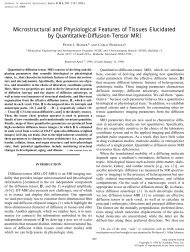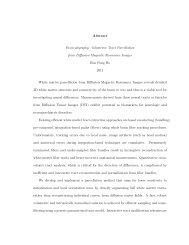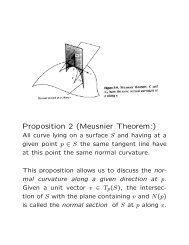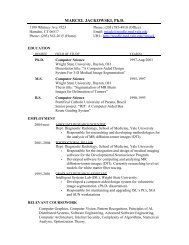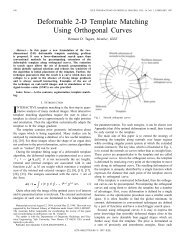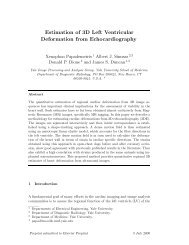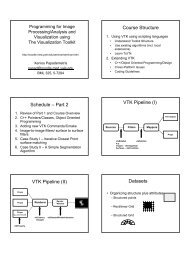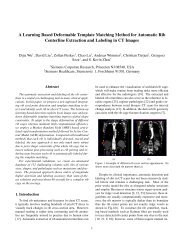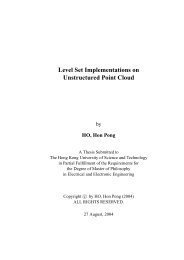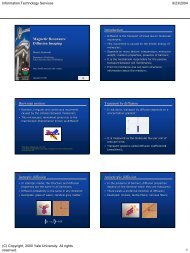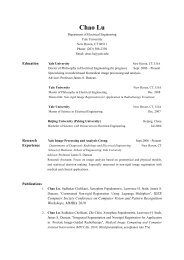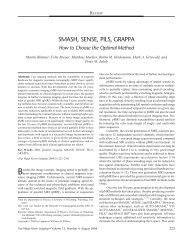Pulsed-field gradient nuclear magnetic resonance as a tool for ...
Pulsed-field gradient nuclear magnetic resonance as a tool for ...
Pulsed-field gradient nuclear magnetic resonance as a tool for ...
Create successful ePaper yourself
Turn your PDF publications into a flip-book with our unique Google optimized e-Paper software.
218<br />
PRICE<br />
Figure 15 The ratio of the signal obtained from the<br />
stimulated echo Ž STE. sequence to that obtained from<br />
the Stejskal and Tanner spin-echo Ž SE. sequence versus<br />
T1T2 in the absence of <strong>gradient</strong>s. The simulations<br />
were calculated using Eqs. 32 and 33 .<br />
In per<strong>for</strong>ming<br />
these simulations, we have <strong>as</strong>sumed that 2 T1 in<br />
the c<strong>as</strong>e of the Stejskal and Tanner sequence and that<br />
2 12T1 in the c<strong>as</strong>e of the STE sequence. The<br />
simulations were per<strong>for</strong>med <strong>for</strong> the c<strong>as</strong>es of 122 Ž . and that 4 Ž ---- .<br />
1 2 . The solid horizontal line<br />
indicates the boundary above which the STE sequence<br />
gives better signal-to-noise than the Stejskal and Tanner<br />
sequence. As expected, when T1T21, the stimulated<br />
echo sequence gives only half the intensity of the<br />
spin-echo sequence.<br />
nal <strong>magnetic</strong> <strong>gradient</strong>s and are not an inherent<br />
<br />
property of the species being me<strong>as</strong>ured Ži.e.,<br />
T2 and not T . 2 . Thus, in addition to simply using the<br />
STE sequence, benefit may be had by using specialized<br />
sequences to counteract the effects of the<br />
internal <strong>gradient</strong>s, and these <strong>for</strong>m the subject of<br />
the following subsection.<br />
Internal Gradients. Ideally, the only <strong>magnetic</strong> <strong>gradient</strong>s<br />
present during the per<strong>for</strong>mance of a PFG<br />
sequence would be the purposely applied constant<br />
<strong>gradient</strong>s. In practice, the B <strong>field</strong> is never<br />
0<br />
perfect Že.g.,<br />
imperfect shimming and the proximity<br />
of the thermocouple to the sample. and nonhomogeneous<br />
internal <strong>gradient</strong>s are common<br />
within many samples Že.g.,<br />
red blood cells, metal<br />
hydrides, colloids, and porous media. owing to<br />
differences in <strong>magnetic</strong> susceptibility. For exam-<br />
ple, it is estimated that red blood cells have<br />
2 1 Ž .<br />
<strong>gradient</strong>s up to 2 10 T m 67, 68 . Even<br />
minute air bubbles in an apple can lead to large<br />
background <strong>gradient</strong>s Ž 69 . . In fact, in hydride<br />
samples, such internal <strong>gradient</strong>s can be of the<br />
1 order of 0.5 T m Ž 70 . . In this section, we<br />
consider the effects of constant and nonconstant<br />
Ž i.e., nonuni<strong>for</strong>m. background <strong>gradient</strong>s Ži.e.,<br />
nonuni<strong>for</strong>m both in direction and magnitude<br />
throughout the sample. on diffusion me<strong>as</strong>urements.<br />
These background <strong>gradient</strong>s result in a<br />
decre<strong>as</strong>e in the observed T2 through the effects<br />
of translational diffusion of <strong>nuclear</strong> spins Ž 7179 . .<br />
This can be e<strong>as</strong>ily understood by considering the<br />
effects of a <strong>gradient</strong> on the Hahn spin-echo sequence<br />
Ž see the discussion below . , although in<br />
fact there is no exact theory <strong>for</strong> treating the<br />
effects of diffusion in a general nonuni<strong>for</strong>m <strong>gradient</strong><br />
Ž 76 . .<br />
Let us begin our investigation of the effect of<br />
background <strong>gradient</strong>s by considering the Stejskal<br />
and Tanner sequence, but in the presence of a<br />
uni<strong>for</strong>m constant background <strong>gradient</strong> of strength<br />
g Ž Fig. 16 .<br />
0 . Using the theory developed in the<br />
first article Žsee<br />
Part 1, The Macroscopic Approach,<br />
and the Maple program in the Appendix.<br />
to calculate the diffusion related part of the attenuation,<br />
we can derive the echo signal amplitude<br />
including the effects of the background<br />
Figure 16 The Stejskal and Tanner Pulse sequence in<br />
the presence of a background <strong>gradient</strong> g 0.<br />
Simplistically,<br />
it is <strong>as</strong>sumed that the background <strong>gradient</strong> is<br />
uni<strong>for</strong>m in magnitude and direction throughout the<br />
entire sample during the sequence.



